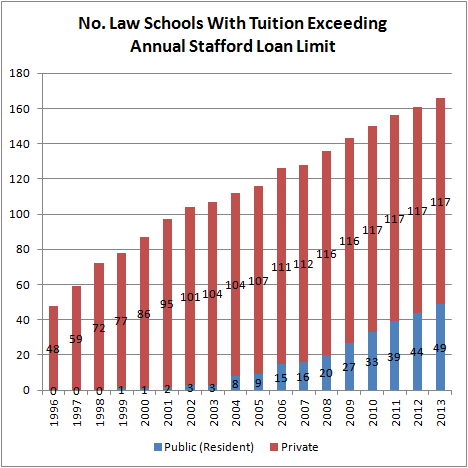Deciding that paper is out, the ABA has moved the information that used to be published in the encyclopedic ABA-LSAC Official Guide to the ABA Law Schools to the Internet. I’m told that the ABA will release a spreadsheet full of the same data to make researchers’ lives easier.
Being a masochist, I went ahead and looked through the full-time tuition numbers anyway.
The biggest overall changes are one new private law school (Belmont), and Texas Wesleyan is now Texas A&M. It’s the first time since 1997 that a private law school has merged with a public university, but I think it will become more common going forward. For instance, South Carolinians were discussing buying up Charleston School of Law a few months ago. Same goes for the University of New Hampshire. In fact, just this weekend Vermont Law School was said to be in merger talks with the University of Vermont.
And yes, I have no idea why a public university would want to buy up a law school that’s losing money and students. Texas A&M, in fact, lost 33 students this year (~$770,000 netting out full-time and part-time students and assuming they’d pay full tuition). It’s like, they must be asking for a reorganization at some point down the road to say nothing of the fact that public law schools are obsolete.
As for tuition … it went up!
(Clicking on this chart shall embiggen it.)
…As did the number of law schools that charge more than the $20,500 annual Stafford loan limit. Welcome to Grad PLUS country, travelers.

Okay, we know at this point that a lot of people aren’t paying full price for legal education anymore, except if they lost their scholarships. Nevertheless, someone has to be paying for the merit aid, and despite the applicant crash, as of two years ago inflation-adjusted revenue from full-time students paying full tuition hadn’t stopped increasing. Even the median law school hauled in more money from full-time, full-paying students than before (~$7.8 million).
For tuition increases, though, the outlier of the year is Thomas M. Cooley Law School, which increased its full-time tuition by $6,400 (17 percent). Meanwhile, its full-time enrollment fell from 604 last year to 386 this year. The number of full-time matriculants this fall was 49, down from 115 last year (57 percent). Wow.
On the other side of the cost curve universe, Arizona’s resident tuition fell by 10 percent, a record low going back to … 2009, when you were listening to the soundtrack to Hannah Montana: The Movie.
I haven’t carefully combed the numbers for this year, but researchers should know that Southern University Law Center reported its semester tuition, not annual.
For private law schools, full-time tuition increases occurred on the more expensive end, but they’re slowing down in tandem, just not as quickly as the inflation rate.

That’s all I’ve got. Peace.

Embiggening things rocks.
“Cutting edge” ABA posts data to internet…20 years into internet era.
More seriously, an interesting question is – why now?
Widely publicized *data* (vs. school sponsored PR/lies) is the enemy of the average law school (and by average I mean 90% of them).
So why (finally) show your dirty, dirty knickers in an easy to access/parse format?
Is the ABA laying the groundwork for the inter-school combat (cue Star Trek combat theme) that the ABA (finally) sees as inevitable?
If the law school industry as a whole is about to get pon farr’d like nobody’s business, the ABA likely wants to help/suck up to the most likely survivors.
Who are *helped* by (finally) making the data easily available.
I think we are seeing the ABA starting to throw schools out of the lifeboat…
Everybody grab your popcorn.
(Bwwwwaaa Haaaaaa Haaaaa Haaaaaa!!!)
I haven’t seen that episode in ages.
The “509 Information Reports,” formerly known as the Official Guide, have been available on the LSAC’s Web site for many years now. The data go back to 2004ish, depending on what you’re talking about.